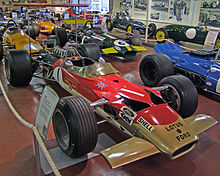Lotus 49
The Lotus 49 was a Formula 1 racing car , built and used from 1967 to 1970 by the British Formula 1 team Lotus .
The Lotus 49 set standards in racing car construction in 1967 and went down in Grand Prix history as the first Formula 1 vehicle with a Ford Cosworth engine running in the rear. After the uncertain first year of the 3-liter formula, which was introduced in Formula 1 in 1966, the Lotus 49 was considered to be groundbreaking for the teams of this formula.
Development history
Lotus team boss Colin Chapman brought the two Ford technicians Haley Coop and Walter Hayes together with Keith Duckworth from Cosworth in 1966 with the aim of developing a new engine for Formula 1. Ford supported the development of the DFV (Double Four Valve = double four valve) intensively and Lotus, with an exclusive contract for the use, cut the Lotus 49 to this engine.
It was an uncomplicated car with timeless lines. The 90-degree V8 engine determined the cross-section of the monocoque . It was fixed behind the cockpit in such a way that it played a supporting role . The rear suspension subframe was bolted to the engine block and cylinder heads. It was time-consuming to change the engines, but the car had a good center of gravity. The drivers raved about the 49, which was light and agile and whose engine had a wide speed range.
Lotus built twelve chassis with the designation 49 (three of which were conversions of the existing ones, but which were given a new build number). One or one of the cars remained an exhibit and was never driven, the other eleven were used under the Evo designations from B to T until the early 1970s. The T with a just 2.5 liter Cosworth V8 was only driven in the Tasman series (hence the T), a racing series in Oceania that was very popular in the late 1960s.
The 1968 Lotus 49B had a longer wheelbase, which from this season allowed wider wheels, a slightly more wedge-shaped body and modified subframes. To improve traction, the front was first fitted with short wings and a spoiler lip was formed at the rear.
In 1969, oversized wings were used at the front and rear, which were mounted on high supports with rubber elements directly on the steering knuckles and not on the vehicle frame, as is the case with the competition. The downforce should not act on the whole car, but only on the wheels. However, the front wing soon proved to be a disadvantage as the supports bent and the tires hit. At the Spanish Grand Prix , the front wings were replaced by wing stubs on both sides of the front hood. The rear wings buckled during the race and ultimately failed completely. First Graham Hill had an accident behind a high-speed jump, but was uninjured. Three laps later, Jochen Rindt had an accident at this point for the same reason. He hit the wreckage of Hill's car and was only recovered from the bent chassis with a broken nose. After these serious accidents in Barcelona, the rear wing was also dismantled. Because during training for the 1969 Monaco Grand Prix , the Commission Sportive Internationale (CSI) finally banned all wings. From now on, only stabilization surfaces attached to the sprung part of the chassis were allowed. Shortly thereafter, the regulation was specified: rear wing a maximum of 800 mm high and a maximum of 1100 mm wide.
The Lotus 49C, which was still used occasionally in 1970, received the three-part rear wing of the Lotus 72.
successes
The 49 was driven by the great champions of its era. Jim Clark celebrated victory with it when he first competed in the Dutch Grand Prix in 1967 . It was also the first win for the Cosworth V8 engine at the first start. Jim Clark also scored his last victory in South Africa in 1968 in a 49. For four years, the Lotus 49 was the measure of all things in Formula 1. Drivers with these racing cars have won world championship races twelve times.
Graham Hill became world champion in 1968 in the 49er for the second time in his career and after 1963 and 1965 brought Lotus the third title of world constructor champion. The Lotus 49 was also the last vehicle to win a Grand Prix when used by a real privateer. Jo Siffert won in 1968 for Rob Walker the Grand Prix of Great Britain in Brands Hatch .
The last success for this legendary racing car was achieved by Jochen Rindt in 1970. Rindt, who was reluctant to drive the new Lotus 72 , went back to the 49 at the Monaco Grand Prix and just won after Jack Brabham braked in the Rascasse on the last lap.
Technical specifications
| Development stage: | 49 (1967) | 49B (1968) | 49B (1969) |
| Engine: | Ford Cosworth V8 (90 °) | ||
| Displacement : | 2995 cc | ||
| Bore × stroke: | 85.74 x 64.77 mm | ||
| Performance at 1 / min: | around 300 kW (410 PS) at 9000 |
around 305 kW (415 hp) at 9500 |
around 315 kW (430 hp) at 10,000 |
| Compression: | 11: 1 | ||
| Valve control: | two overhead camshafts per cylinder bank, driven by gear wheels |
||
| Cooling: | water | ||
| Transmission: | ZF 5DS-12 (fully synchronized) |
Hewland FG400 or DG300 |
Hewland DG300 |
| Front suspension: | Double wishbones (different lengths), internal coil springs with dampers, anti-roll bar |
||
| Rear suspension: | Double wishbones (different lengths), push rods above and below, coil springs and dampers |
||
| Chassis and structure: |
Monocoque made of Alclad , engine / gearbox flanged as a load-bearing component, front subframe (wing, water cooler) |
||
| Track width front / rear: | 1524/1549 mm | 1590/1549 | |
| Wheelbase: | 2413 mm | 2489 mm | |
| Bikes: | 15 ″ Lotus Magnesium | ||
| Length of the car: | 4013 mm | ||
| Dry weight : | 500 kg | 535 kg | 540 kg |
| Takeoff weight: | 709 kg | 744 kg | |
literature
- David Hodges: The Lotus 49 (= series car types. Vol. 4). Motorbuch-Verlag, Stuttgart 1971 (English original edition: The Lotus 49. L. Leventhal, London 1970, ISBN 0-85368-051-5 ).
- Michael Oliver: Lotus 49. The story of a legend. Veloc Publishing, Dorchester 1999, ISBN 1-901295-51-6 .
Web links
Individual evidence
- ^ Graham Hill at Sainte Devote . Retrieved January 31, 2010.






